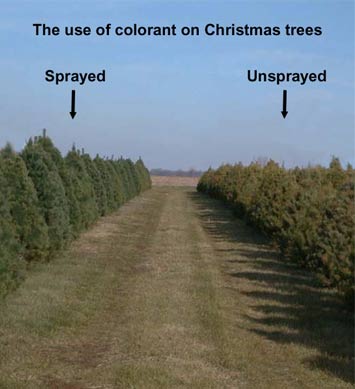A real Christmas tree is a more "eco-friendly" choice for the season because it is a renewable and biodegradable natural resource.
On average, a tree takes about seven years to grow to market size. During that time, it:
- absorbs carbon dioxide.
- filters the air of particulate matter.
- releases oxygen.
- provides watershed protection.
- creates habitat for songbirds and other wildlife.
Artificial trees are made primarily of metals and plastics, all non-renewable resources and is used on average for seven years. The plastic material, typically polyvinyl chloride (PVC) is a potential source of lead. The potential for lead poisoning is considered high enough that California requires a warning label on all artificial trees made in China. The majority of artificial trees are made in China.
How trees are grown
Christmas trees are planted and raised as a crop by tree farmers. Unlike other row crops, a tree plantation remains green and grows year-round. On average, for every tree that is harvested, about two to three seedlings are planted.
The trees begin as small seedlings, less than a foot tall. Once planted, grass and weed control is important. The field is mowed during the summer and kept free of weeds around the seedlings. Throughout the growing season, the farmer monitors the plantation for insects and disease and treats the trees if necessary.
After a few years, shearing begins. The trees are pruned each year until ready for market. This period ranges from 5-15 years depending on species. Unsheared trees will take on an appearance of a "Charlie Brown" tree - skinny and spindly.

Once a tree is ready for market, a green colorant is sprayed on the tree. It is natural for most evergreen trees to take on a yellow cast during winter months. The spray maintains a deep green color and keeps the needles from drying out. Some spray residue may appear on the tree’s trunk.
Tree selection
Always choose a fresh tree. At retail lots, some trees may have been harvested a month or more before being put on sale. To check condition, pull a branch toward you. If green needles fall, look for another tree.
Trees are generally not sold with standing water, because their water-carrying vessels seal within a few hours of being cut. As long as trees are kept outdoors in cool temperatures, they will not dry out. It is only when they are taken indoors to a warmer, drier environment that they lose moisture quickly.
Once selected, the tree should be shaken. Some retailers and farms offer mechanical shaking. If not available, vigorously shake the tree at home on a driveway or sidewalk. It is normal for trees to have dead needles on the inner branches. Use a Christmas tree bag to make moving easier and less messy. Bags can also serve as a tree skirt.
Some people choose balled and burlapped (B&B) trees to plant after the holidays. To plant successfully:
- Keep the tree outdoors and only bring it indoors for a few days.
- The tree will be heavy and difficult to move.
- Dig the planting hole before the ground freezes.
Tree care and safety
The tree’s base may need to be adjusted for height. It may also need unclogged. When cut, sap clogs the tree’s water carrying-vessels. Place the tree in a water stand as soon as possible to prevent this. Otherwise, cut a half-inch from the trunk’s base.
Indoors, a tree will quickly dry. Keep water in the stand and periodically check freshness by testing the needles. They should be flexible and firmly attached to the branches, not loose or brittle. For the first few days, the tree may need up to a quart of water each day. If if dries, the vessels that take up water will close, making future watering ineffective.
Christmas trees are generally not a fire hazard. According to the National Fire Protection Association, approximately 1/10 of one percent of residential fires involve a Christmas tree (both real and artificial). Fires are far more likely to start from overloaded and faulty wiring igniting wrapping paper and packages.
Tree disposal
Options include:
- taking the tree to a designated Christmas tree recycling site,
- tossing it in the backyard to provide shelter for wintering birds or other wildlife,
- running it through a wood chipper to create mulch,
- or chopping it up for firewood.
One option the DNR doesn’t generally suggest is tossing trees into a lake to create fish attractors. Discarding a Christmas tree on a private pond is at the owner’s discretion, but doing so on public freshwater lakes is governed by the Lake Preservation Act (Indiana Code 14-26-2) and Indiana Administrative Code (312 IAC 11-4-7).
Those two laws require a license from the DNR to construct or place a fish attractor in a public freshwater lake. To qualify, the fish attractor must be anchored to ensure proper setting and must not be placed in a channel, a beach area, near the lake surface or in an area that would adversely affect public safety and navigation, or adversely affect the natural resources or natural scenic beauty. If approved, the permit carries a $100 fee and requires the permit holder to remove any portion or portions of the fish attractor that become unattached.
